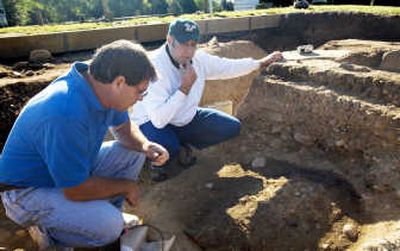George Washington’s boyhood home unearthed

After years of searching, archaeologists have identified and excavated the boyhood home of George Washington, site of such legendary – if apocryphal – events as chopping down the cherry tree and throwing a silver dollar across the Rappahannock River.
The find indicates that the Washington family lived in a spacious eight-room home, a sign the family was well-off for its day, and provides new information about his childhood – a period that has remained largely obscured in the mists of history.
“We all know that much of our character is formed in our early years, so to be able to have access to the very specific place and the material conditions of what life was like will help us sort out who this man Washington was,” said archaeologist Julia King of St. Mary’s College of Maryland, who was not involved in the research.
The house is in Stafford County, Va., on a property now known as Ferry Farm, on the banks of the Rappahannock across from Fredericksburg and about 50 miles south of Washington.
Researchers uncovered the remains of two chimney bases, two stone-lined cellars and two root cellars, along with thousands of artifacts that convinced them this was the Washington homestead. The size, characteristics and location of the structure were the deciding factors, the researchers said. “This is it – this is the site of the house where George Washington grew up,” archaeologist David Muraca of the George Washington Foundation said in a news conference Wednesday.
“If George Washington did indeed chop down a cherry tree, as generations of Americans have believed, this is where it happened,” added archaeologist Philip Levy of the University of South Florida, co-leader of the excavation.
George’s father, Augustine, bought the 600-acre parcel and moved his family there in 1738 so that he could be closer to the Accokeek Creek Iron Furnace, which he managed. George inherited the farm at age 11 when his father died in 1743 and eventually sold it after he moved to Mount Vernon.
Originally known as the Washington Farm, it became known as the Ferry Farm because of the ferry at the site that carried travelers across the Rappahannock.
Over the years, development has encroached, and now about 113 acres are preserved as a National Historic Landmark.
The team initially identified five sites on the property that might be the Washington house. The first two they excavated proved to be an earlier farmhouse built on the site and a 19th century house. The third one was the charm.
The project, led by the George Washington Foundation, was funded by National Geographic and the Dominion Foundation.
The foundation plans to construct a historic trail linking Mount Vernon, Ferry Farm and Washington’s birthplace at Pope’s Creek. They also plan to reconstruct the buildings that were standing in the 1740s, using tools and construction techniques from the period. That work is scheduled to begin in three to four years.